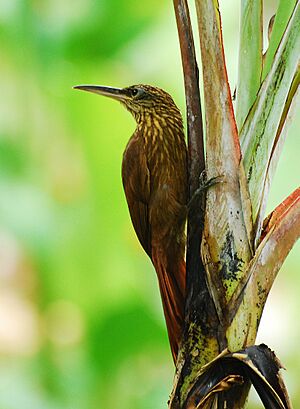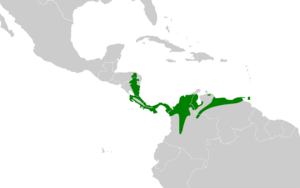Cocoa woodcreeper facts for kids
Quick facts for kids Cocoa woodcreeper |
|
|---|---|
 |
|
| Conservation status | |
| Scientific classification | |
| Genus: |
Xiphorhynchus
|
| Species: |
susurrans
|
| Subspecies | |
|
See text |
|
 |
|
| Synonyms | |
|
|
The cocoa woodcreeper (Xiphorhynchus susurrans) is a type of bird that belongs to the ovenbird family called Furnariidae. You can find this bird in several countries, including Colombia, Costa Rica, Guatemala, Honduras, Nicaragua, Panama, Trinidad and Tobago, and Venezuela.
Contents
About the Cocoa Woodcreeper
The cocoa woodcreeper used to be considered the same as another bird, the buff-throated woodcreeper. But since the 1990s, scientists have decided it's its own separate species. These two birds are very closely related. Scientists are still studying the different types (subspecies) of cocoa woodcreepers to understand them better.
There are eight different types, or subspecies, of the cocoa woodcreeper. They are grouped into two main families:
- "Lawrence's" or "nana" group
- X. s. confinis (Bangs, 1903)
- X. s. costaricensis (Ridgway, 1888)
- X. s. marginatus Griscom, 1927
- X. s. nana (Lawrence, 1863)
- X. s. rosenbergi Bangs, 1910
- "Cocoa" or "susurrans" group
- X. s. jardinei (Dalmas, 1900)
- X. s. margaritae Phelps, Sr. & Phelps, Jr., 1949
- X. s. susurrans (Jardine, 1847)
What Does It Look Like?
The cocoa woodcreeper is about 21 to 25.5 centimeters (8.3 to 10 inches) long. It weighs between 43 and 58 grams (1.5 to 2 ounces). It's a medium-sized bird with a long, slightly curved beak. Both male and female birds look alike.
Adult cocoa woodcreepers usually have a dark face with light streaks and a whitish stripe above their eye, like an eyebrow. Their head and neck are dark brown or blackish with light spots that look like streaks. Their upper back and wing feathers are olive-brown to brown, with dark-edged streaks. Their lower back, tail, and flight feathers are a reddish-brown color.
Their throat is whitish or pale buff with thin dark marks. Their chest and belly are reddish-brown, becoming redder near their tail. Their upper chest has light spots with dark edges, which turn into thin streaks lower down. Their eyes are dark brown, and their beak is mostly black. Their legs and feet are dark blue-gray or greenish-gray. Young birds are darker overall and have a shorter, blacker beak.
The different subspecies of the cocoa woodcreeper have slight differences in their colors and markings:
- "Cocoa" or "susurrans" group (usually has spots on its underside)
- X. s. jardinei: Has a more reddish back and deeper buff colors on its throat and belly.
- X. s. margaritae: Has spots on its throat instead of a scaly pattern.
- "Lawrence's" or "nana" group (usually has streaks on its underside)
- X. s. nana: Has a deep buff throat and bold streaks on its chest and belly.
- X. s. confinis: Has a whiter throat and weaker but more widespread streaks than nana.
- X. s. costaricensis: Has a darker, deeper reddish back and rump, and darker, more olive underparts. It has fewer streaks than nana.
- X. s. marginatus: Has darker chestnut wings and tail, larger dark tips on its main flight feathers, and a brighter buff throat.
- X. s. rosenbergi: Is very similar to nana but has wider and more boldly edged streaks on its chest.
Where Does It Live?
The different types of cocoa woodcreepers live in specific areas:
- X. s. confinis: Lives on the Caribbean side of eastern Guatemala and northern Honduras.
- X. s. costaricensis: Found on both Caribbean and Pacific sides from southeastern Honduras through Nicaragua and Costa Rica into western Panama.
- X. s. marginatus: Lives on the Pacific side of central Panama.
- X. s. nana: Found on both Caribbean and Pacific sides of eastern Panama, much of northern Colombia, and northern and western Venezuela.
- X. s. rosenbergi: Lives in the upper Cauca Valley in Colombia.
- X. s. jardinei: Found in northeastern Venezuela.
- X. s. margaritae: Lives on Isla Margarita off the coast of Venezuela.
- X. s. susurrans: Lives in Trinidad and Tobago, with one sighting in mainland Venezuela.
The cocoa woodcreeper mostly lives in wet evergreen forests. It likes places like forests along rivers (called gallery forests), forests where trees lose their leaves, and the edges of old and mature new forests. It's less common deep inside old forests or in young new forests. It can also be found in mangroves along some coasts and in dry scrub areas on Isla Margarita. It usually lives below 900 meters (3,000 feet) in elevation, but can be found up to 1,600 meters (5,200 feet) in Colombia and sometimes even 2,400 meters (7,900 feet) in Venezuela.
How Does It Behave?
Movement
The cocoa woodcreeper stays in the same area all year round; it does not migrate.
Feeding
The cocoa woodcreeper mainly eats arthropods, which are creatures like insects and spiders. Sometimes, it also eats small animals like frogs and lizards. It usually looks for food by itself. However, it sometimes joins groups of different bird species that are feeding together. It also follows army ant swarms, eating the insects that the ants stir up.
When it's with other birds, it usually looks for food in the middle part of the forest. When it's following ants, it forages much closer to the ground. Away from ants, it climbs up tree trunks, often in a spiral, and along branches, sometimes even on their underside. It finds most of its food by picking insects from cracks in bark, and by poking into dead leaves, plants growing on trees (called epiphytes), moss, and holes in trees. It might also peck at rotting wood or peel off bark.
Breeding
The cocoa woodcreeper's breeding season changes a bit depending on where it lives, but it's generally from May to August. It usually builds its nest in natural holes in trees, but sometimes it uses human-made structures. It adds small pieces of bark, wood chips, and soft plant material to the nest hole. From the few observations, we know that it usually lays two eggs. The eggs hatch after about 19 to 20 days. The young birds leave the nest at least 17 days after hatching. It seems that only the female bird sits on the eggs and takes care of the babies.
Vocalization
The cocoa woodcreeper is quite loud! During the breeding season, it sings for long periods at dawn and dusk, and sometimes even during the day. Its song is a loud series of 7 to 20 clear, rising whistles. It might sound like "ki, ki, kuee, kuee, whe, whew, whew, whew, whew." It also has a "long call" that sounds like steady, rolling laughter, getting louder in the middle: "weet-weet-WEET-WEET-WEET-WEET-WEET-WEET-WEET-WEET." Other calls include "cheer", "pyewl", "chu", and "choe".
Status and Safety
The IUCN (International Union for Conservation of Nature) has decided that the cocoa woodcreeper is a species of "Least Concern." This means it's not currently in danger of disappearing. It lives in a very large area and has an estimated population of at least 500,000 adult birds. However, this number is thought to be going down. No immediate threats have been found for this bird.
It is considered fairly common in most of its range, but it can be uncommon or rare in higher places and in northern Central America. People have noticed that it prefers forest edges and areas where new trees are growing. This suggests it's not too sensitive to human activity. However, it still needs at least some patches of forest to survive.
Images for kids
-
X. s. costaricensis at Cordillera de Talamanca, Costa Rica




